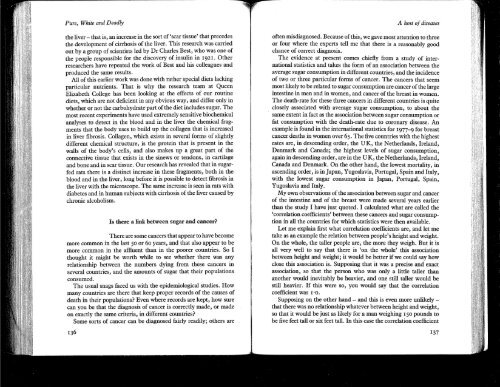John_Yudkin_-_Pure_White_and_Deadly_revised_1986_OCR
John_Yudkin_-_Pure_White_and_Deadly_revised_1986_OCR
John_Yudkin_-_Pure_White_and_Deadly_revised_1986_OCR
You also want an ePaper? Increase the reach of your titles
YUMPU automatically turns print PDFs into web optimized ePapers that Google loves.
- - --------------------<br />
<strong>Pure</strong>, <strong>White</strong> <strong>and</strong> <strong>Deadly</strong><br />
the liver - that is, an increase in the sort of 'scar tissue' that precedes<br />
the development of cirrhosis of the liver. This research was carried<br />
out by a group of scientists led by Dr Charles Best, who was one of<br />
the people responsible for the discovery of insulin in 1921. Other<br />
researchers have repeated the work of Best <strong>and</strong> his colleagues <strong>and</strong><br />
produced the same results.<br />
All of this earlier work was done with rather special diets lacking<br />
particular nutrients. That is why the research team at Queen<br />
Elizabeth College has been looking at the effects of our routine<br />
diets, which are not deficient in any obvious way, <strong>and</strong> differ only in<br />
whether or not the carbohydrate part of the diet includes sugar. The<br />
most recent experiments have used extremely sensitive biochemical<br />
analyses to detect in the blood <strong>and</strong> in the liver the chemical fragments<br />
that the body uses to build up the collagen that is increased<br />
in liver fibrosis. Collagen, which exists in several forms of slightly<br />
different chemical structure, is the protein that is present in the<br />
walls of the body's cells, <strong>and</strong> also makes up a great part of the<br />
connective tissue that exists in the sinews or tendons, in cartilage<br />
<strong>and</strong> bone <strong>and</strong> in scar tissue. Our research has revealed that in sugarfed<br />
rats there is a distinct increase in these fragments, both in the<br />
blood <strong>and</strong> in the liver, long before it is possible to detect fibrosis in<br />
the liver with the microscope. The same increase is seen in rats with<br />
diabetes <strong>and</strong> in human subjects with cirrhosis of the liver caused by<br />
chronic alcoholism.<br />
Is there a link hetween sugar <strong>and</strong> cancer?<br />
There are some cancers that appear to have become<br />
more common in the last 50 or 60 years, <strong>and</strong> that also appear to be<br />
more common in the affluent than in the poorer countries. So I<br />
thought it might be worth while to see whether there was any<br />
relationship between the numbers dying from these cancers in<br />
several countries, <strong>and</strong> the amounts of sugar that their popUlations<br />
consumed.<br />
The usual snags faced us with the epidemiological studies. How<br />
many countries are there that keep proper records of the causes of<br />
death in their populations? Even where records are kept, how sure<br />
can you be that the diagnosis of cancer is correctly made, or made<br />
on exactly the same criteria, in different countries?<br />
Some sorts of cancer can be diagnosed fairly readily; others are<br />
136<br />
A host of diseases<br />
often misdiagnosed. Because of this, we gave most attention to three<br />
or four where the experts tell me that there is a reasonably good<br />
chance of correct diagnosis.<br />
The evidence at present comes chiefly from a study of international<br />
statistics <strong>and</strong> takes the form of an association between the<br />
average sugar consumption in different countries, <strong>and</strong> the incidence<br />
of tW9 or three particular forms of cancer. The cancers that seem<br />
most likely to be related to sugar consumption are cancer of the large<br />
intestine in men <strong>and</strong> in women, <strong>and</strong> cancer of the breast in women.<br />
The death-rate for these three cancers in different countries is quite<br />
closely associated with average sugar consumption, to about the<br />
same extent in fact as the association between sugar consumption or<br />
fat consumption with the death-rate due to coronary disease. An<br />
example is found in the international statistics for 1977-9 for breast<br />
cancer deaths in women over 65. The five countries with the highest<br />
rates are, in descending order, the UK, the Netherl<strong>and</strong>s, Irel<strong>and</strong>,<br />
Denmark <strong>and</strong> Canada; the highest levels of sugar consumption,<br />
again in descending order, are in the UK, the Netherl<strong>and</strong>s, Irel<strong>and</strong>,<br />
Canada <strong>and</strong> Denmark. On the other h<strong>and</strong>, the lowest mortality, in<br />
ascending order, is in Japan, Yugoslavia, Portugal, Spain <strong>and</strong> Italy,<br />
with the lowest sugar consumption in Japan, Portugal, Spain,<br />
Yugoslavia <strong>and</strong> Italy.<br />
My own observations of the association between sugar <strong>and</strong> cancer<br />
of the intestine <strong>and</strong> of the breast were made several years earlier<br />
than the study I have just quoted. I calculated what are called the<br />
'correlation coefficients' between these cancers <strong>and</strong> sugar consumption<br />
in all the countries for which statistics were then available.<br />
Let me explain first what correlation coefficients are, <strong>and</strong> let me<br />
take as an example the relation between people's height <strong>and</strong> weight.<br />
On the whole, the taller people are, the more they weigh. But it is<br />
all very well to say that there is 'on the whole' this association<br />
between height <strong>and</strong> weight; it would be better if we could say how<br />
close this association is. Supposing that it was a precise <strong>and</strong> exact<br />
association, so that the person who was only a little taller than<br />
another would inevitably be heavier, <strong>and</strong> one still taller would be<br />
still heavier. If this were so, you would say that the correlation<br />
coefficient was 1'0.<br />
Supposing on the other h<strong>and</strong> - <strong>and</strong> this is even more unlikely -<br />
that there was no relationship whatever between height <strong>and</strong> weight,<br />
so that it would be just as likely for a man weighing 150 pounds to<br />
be five feet tall or six feet tall. In this case the correlation coefficient<br />
137



